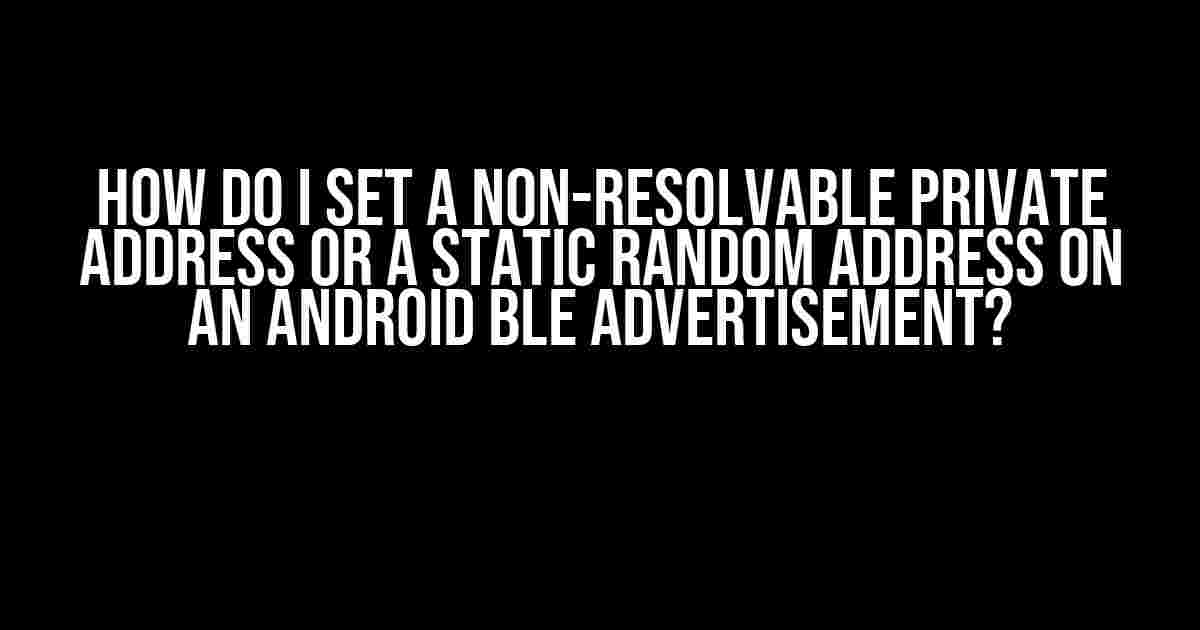Welcome to the world of Bluetooth Low Energy (BLE) and Android development! If you’re reading this article, chances are you’re looking to create a seamless and secure BLE experience for your users. One crucial aspect of this is setting a Non-Resolvable Private Address (NRPA) or a Static Random Address (SRA) on your Android BLE advertisement. But, you might be wondering, what’s the difference between these two types of addresses, and how do I actually set them up?
Understanding Non-Resolvable Private Addresses (NRPAs) and Static Random Addresses (SRAs)
Before we dive into the implementation details, let’s take a step back and understand the basics.
Non-Resolvable Private Addresses (NRPAs)
A Non-Resolvable Private Address (NRPA) is a type of private address that is not resolvable to a fixed device identity. This means that the address is not linked to a specific device, making it more secure and private. NRPAs are typically used in scenarios where device identity needs to be protected, such as in IoT or wearable devices.
Static Random Addresses (SRAs)
A Static Random Address (SRA) is a type of address that is randomly generated and remains the same for a specific duration, typically the lifetime of the device. SRAs are used to provide a level of privacy and security, as they make it difficult for an attacker to track a device over time.
Setting up NRPAs and SRAs on Android BLE Advertisement
Now that we’ve covered the basics, let’s get our hands dirty and implement NRPAs and SRAs on our Android BLE advertisement.
Step 1: Set up your Android project
First, create a new Android project in Android Studio. Make sure you have the necessary permissions and dependencies in your `AndroidManifest.xml` file:
<uses-permission android:name="android.permission.BLUETOOTH"></uses-permission>
<uses-permission android:name="android.permission.BLUETOOTH_ADMIN"></uses-permission>
<uses-feature
android:name="android.hardware.bluetooth_le"
android:required="true"></uses-feature>
Step 2: Initialize the BLE adapter
In your activity or service, initialize the BLE adapter:
private BluetoothAdapter mBluetoothAdapter; // ... mBluetoothAdapter = BluetoothAdapter.getDefaultAdapter();
Step 3: Generate a NRPA or SRA
Use the `BluetoothAdapter` to generate a NRPA or SRA:
// Generate a NRPA byte[] nrpa = mBluetoothAdapter.getBluetoothLeScanner().generateRandomAddress(true); // Generate a SRA byte[] sra = mBluetoothAdapter.getBluetoothLeScanner().generateRandomAddress(false);
Step 4: Set the advertisement address
Set the generated address on your BLE advertisement:
// Create a BLE advertisement data
AdvertiseData.Builder dataBuilder = new AdvertiseData.Builder();
// Set the address
dataBuilder.setDeviceAddress(nrpa); // or sra
// Set other advertisement data (optional)
dataBuilder.setIncludeDeviceName(true);
dataBuilder.setIncludeTxPowerLevel(true);
// Create the advertisement
AdvertiseSettings settings = new AdvertiseSettings.Builder()
.setAdvertiseMode(AdvertiseSettings.ADVERTISE_MODE_LOW_LATENCY)
.setTxPowerLevel(AdvertiseSettings.TX_POWER_MEDIUM)
.setTimeout(0) // Advertise indefinitely
.build();
mBluetoothAdapter.getBluetoothLeAdvertiser().startAdvertising(settings, dataBuilder.build(), callback);
Troubleshooting and Best Practices
While setting up NRPAs and SRAs on your Android BLE advertisement, keep the following tips and gotchas in mind:
- Android 10 and above:** On Android 10 and above, you need to use the ` BluetoothLeScanner.generateRandomAddress()` method to generate a NRPA or SRA. On earlier Android versions, use the `BluetoothAdapter.getAddress()` method.
- Address rotation:** To maintain privacy and security, it’s essential to rotate your NRPAs or SRAs regularly. You can do this by generating a new address and updating your advertisement periodically.
- Advertisement filtering:** If you’re using a NRPA, ensure that your advertisement filtering is set up correctly to allow connections from unknown devices.
- Interoperability:** When using NRPAs or SRAs, ensure that your device is compatible with other BLE devices that may not support these types of addresses.
Conclusion
In this comprehensive guide, we’ve covered the basics of Non-Resolvable Private Addresses (NRPAs) and Static Random Addresses (SRAs), and provided step-by-step instructions on how to set them up on an Android BLE advertisement. By following these best practices and troubleshooting tips, you’ll be well on your way to creating a secure and private BLE experience for your users.
| Address Type | Description | Android Implementation |
|---|---|---|
| NRPA | Non-Resolvable Private Address | generateRandomAddress(true) |
| SRA | Static Random Address | generateRandomAddress(false) |
Remember, a secure and private BLE experience is just a few lines of code away!
Here are 5 Questions and Answers about “How do I set a Non-Resolvable Private Address or a Static Random Address on an Android BLE Advertisement?” in HTML format:
Frequently Asked Question
Curious about setting up a Non-Resolvable Private Address or a Static Random Address on your Android BLE advertisement? We’ve got you covered!
Can I set a Non-Resolvable Private Address on an Android BLE advertisement?
Yes, you can! Android 10 (API level 29) and later versions support setting a Non-Resolvable Private Address (NRPA) on a BLE advertisement. To do this, you’ll need to use the `setPrivacyEnabled()` method and set `PRIVACY_MODE_NETWORK_PRIVATE` as the privacy mode.
How do I set a Static Random Address on an Android BLE advertisement?
To set a Static Random Address (SRA) on an Android BLE advertisement, use the `setAddress()` method and pass a random address that you’ve generated. Make sure to use a valid BLE address format, and that the address is not already in use by another device.
What are the benefits of using a Non-Resolvable Private Address on an Android BLE advertisement?
Using an NRPA on an Android BLE advertisement helps to protect user privacy by making it impossible for other devices to resolve the private address to a specific device. This is especially useful in scenarios where you want to prevent tracking or identification of a device.
Can I set a Non-Resolvable Private Address on an Android BLE advertisement on older Android versions?
Unfortunately, no. Support for setting an NRPA on an Android BLE advertisement is only available on Android 10 (API level 29) and later versions. If you need to support older Android versions, you may need to consider alternative approaches or workarounds.
Are there any limitations or restrictions on using a Static Random Address on an Android BLE advertisement?
Yes, there are some limitations to keep in mind when using an SRA on an Android BLE advertisement. For example, you’ll need to ensure that the address is unique and not already in use by another device. Additionally, some devices or platforms may not support SRAs, so be sure to test your implementation thoroughly.

